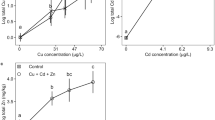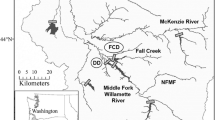Abstract
We conducted a laboratory evaluation to assess the risk to early life stage (i.e., eyed egg to swim up) fall Chinook salmon (Oncorhynchus tshawytscha) for exposure to hexavalent chromium from a contaminated groundwater source. Local populations of fall Chinook salmon were exposed to Hanford Site source groundwater that was diluted with Columbia River water. Specific endpoints included survival, development rate, and growth. Tissue burdens of fish were also measured to estimate uptake and elimination rates of chromium. Survival, development, and growth of early life stage fall Chinook salmon were not adversely affected by extended exposures (i.e., 98 day) to hexavalent chromium ranging from 0.79 to 260 μg/l. Survival for all treatment levels and controls exceeded 98% at termination of the test. In addition, there were no differences among the mean lengths and weights of fish among all treatment groups. Whole-body concentrations of chromium in early life stage fall Chinook salmon had a typical dose-response pattern; i.e., those subjected to highest exposure concentrations and longest exposure intervals had higher tissue concentrations. Given the spatial extent of chromium concentrations at the Hanford Site, and the dynamics of the groundwater–river water interface, the current cleanup criterion of 10 μg/l chromium appear adequate to protect early life stage fall Chinook salmon. These findings, together with previous research indicate low risk to these populations.
Similar content being viewed by others
References
Battelle & USGS (2000). Assessment of the impacts of development and operation of the Columbia River hydroelectric system on mainstem riverine processes and salmon habitats. Prepared by Battelle’s Pacific Northwest Division and US Geological Survey for Bonneville Power Administration, Portland, Oregon.
Becker, C. D. (1973). Food and growth parameters of juvenile Chinook salmon, Oncorhynchus tshawytscha, from the central Columbia River. Fishery Bulletin, 71, 387–400.
Blanchard, F. A., Takahashi, I. T., Alexander, H. C., & Barlett, E. A. (1977). Uptake, clearance, and bioconcentration of c-sec-butyl-4-chlorodiphenyl oxide in rainbow trout. In F. L. Meyer & J. L. Hamelink (Eds.), Aquatic toxicology and hazard evaluation (pp. 162–177). ASTM STP 634, American Society of Testing and Materials, Philadelphia, Pennsylvania.
Buhler, D. R., Caldwell, S. R., & Stokes, R. M. (1969). Tissue accumulation and metabolic effects of hexavalent chromium in trout. Pacific Northwest Laboratory annual report for 1968 to the USAEC Division of Biology and Medicine, Vol. 1, Life Sciences, Part 2 Ecological Sciences (pp. 2.7–2.13). BNWL-1050 PT2, Battelle, Pacific Northwest Laboratories, Richland, Washington.
Collett, D. (1994). Modeling survival data in medical research. London: Chapman and Hall.
Conover, W. J. (1999). Practical nonparametric statistics (3rd ed.). New York: Wiley.
Cox, D. R., & Oakes, D. (1984). Analysis of survival data. London: Chapman and Hall.
Dauble, D. D., & Watson, D. G. (1997). Status of fall Chinook salmon populations in the mid-Columbia River, 1948–1992. North American Journal of Fisheries Management, 17, 283–300.
Eisler, R. (1986). Chromium hazards to fish, wildlife, and invertebrates: A synoptic review. US Fish and Wildlife Service. Biological Report, 85(1.6), 60.
Elandt-Johnson, R. C., & Johnson, N. L. (1980). Survival models and data analysis. New York: Wiley.
Farag, A. M., Harper, D. D., Cleveland, L., Brumbaugh, W. G., & Little, E. E. (2006a). The potential for chromium to affect the fertilization process of Chinook (Oncorhynchus tshawytscha) in the Hanford Reach of the Columbia River, Washington, USA. Archives of Environmental Contamination and Toxicology, 50, 575–579.
Farag, A. M., May, T., Marty, G. D., Easton, M., Harper, D. D., Little, E. E., et al. (2006b). The effect of chronic chromium exposure on the health of Chinook salmon (Oncorhynchus tshawytscha). Aquatic Toxicology, 76, 246–257.
Geist, D. R. (2000). Hyporheic discharge of river water into fall Chinook salmon (Oncrohynchus tshawytscha) spawning areas in the Hanford Reach, Columbia River. Canadian Journal of Fisheries and Aquatic Sciences, 57, 1647–1656.
Geist, D. R., Poston, T. M., & Dauble, D. D. (1994). Assessment of potential impacts of major groundwater contaminants to fall Chinook salmon (Oncorhynchus tshawytscha) in the Hanford Reach, Columbia River. PNL-9990. Richland, Washington: Pacific Northwest Laboratory.
Hamelink, J. L. (1977). Current bioconcentration test methods and theory. In F. L. Meyer & J. L. Hamelink (Eds.), Aquatic toxicology and hazard evaluation (pp. 149–161). ASTM STP 634. Philadelphia, Pennsylvania: American Society of Testing and Materials.
Hartman, M. J., Morasch, L. F., & Webber, W. D. (2000). Hanford site groundwater report for fiscal year 1999. PNNL-13116. Richland, Washington: Pacific Northwest National Laboratory.
Hartman, M. J., Morasch, L. F., & Webber, W. D. (Eds.) (2001). Hanford site groundwater monitoring for fiscal year 2000. PNNL-13404. Richland, Washington: Pacific Northwest National Laboratory.
Hope, S. J., & Peterson, R. E. (1996). Pore water chromium concentrations at 100-H reactor area adjacent to fall Chinook salmon spawning habitat of the Hanford reach, Washington. BHI-00345, Rev. 1, Bechtel Hanford, Inc., Richland, Washington.
Kimbrough, R. A., Smith, R. R., Ruppert, G. P., Wiggins, W. D., Knowles, S. M., & Renslow, V. F. (2001). Water resources data, Washington, water year 2000. US Geological Survey Water-Data Report WA-00-1.
Leland, H. V., & Kuwabara, J. S. (1985). Trace metals. In G. M. Rand & S. R. Petrocelli (Eds.), Fundamentals of aquatic toxicology (pp. 374–415). Washington, District of Columbia: Hemisphere.
Moser, D. P., Fredrickson, J. K., Geist, D. R., Artzen, A. V., Peacock, A. D., Li, S. W., et al. (2003). Biogeochemical processes and microbial characteristics across groundwater-surface water boundaries of the Hanford Reach of the Columbia River. Environmental Science & Technology, 37, 5127–5134.
Mount, D. I., & Brungs, W. A. (1967). A simplified dosing apparatus for fish toxicology studies. Water Research, 1, 21–29.
Olson, P. A., & Foster, R. F. (1956). Effect of chronic exposure to sodium dichromate on young Chinook salmon and rainbow trout. Hanford Biological Research Annual Report 1955. Atomic Energy Commission, HW-41500, Richland, Washington.
Poston, T. M., Hanf, R. W. & Dirkes, R. L. (Eds.) (2000). Hanford site environmental report for calendar year 1999. PNNL-13230. Richland, Washington: Pacific Northwest National Laboratory.
Roberts, A. P., & Oris, J. T. (2004). Multiple biomarker response in rainbow trout during exposure to hexavalent chromium. Comparative Biochemistry and Physiology, Part C, 138, 221–228.
Thornton, E. C., Amonette, J. E., Oliver, J. A., & Haung, D. L. (1995). Speciation and transport characteristics of chromium in the 100-D/100-H areas of the Hanford Site. WHC-SD-EN-TI-302, Rev.0, July 1995, Westinghouse Hanford Company, Richland, Washington.
Van Verst, S. P., Albin, C. L., Patton, G. W., Blanton, M. L., Poston, T. M., Cooper, A. T., et al. (1998). Survey of radiological contaminants in the near-shore environment at the Hanford Site 100-N reactor area. PNNL-11933. Richland, Washington: Pacific Northwest National Laboratory.
Author information
Authors and Affiliations
Corresponding author
Rights and permissions
About this article
Cite this article
Patton, G., Dauble, D. & McKinstry, C. Evaluation of Early Life Stage Fall Chinook Salmon Exposed to Hexavalent Chromium from a Contaminated Groundwater Source. Environ Monit Assess 133, 285–294 (2007). https://doi.org/10.1007/s10661-006-9583-0
Received:
Accepted:
Published:
Issue Date:
DOI: https://doi.org/10.1007/s10661-006-9583-0




